coolant level JEEP CHEROKEE 2017 KL / 5.G User Guide
[x] Cancel search | Manufacturer: JEEP, Model Year: 2017, Model line: CHEROKEE, Model: JEEP CHEROKEE 2017 KL / 5.GPages: 615, PDF Size: 5.72 MB
Page 132 of 615
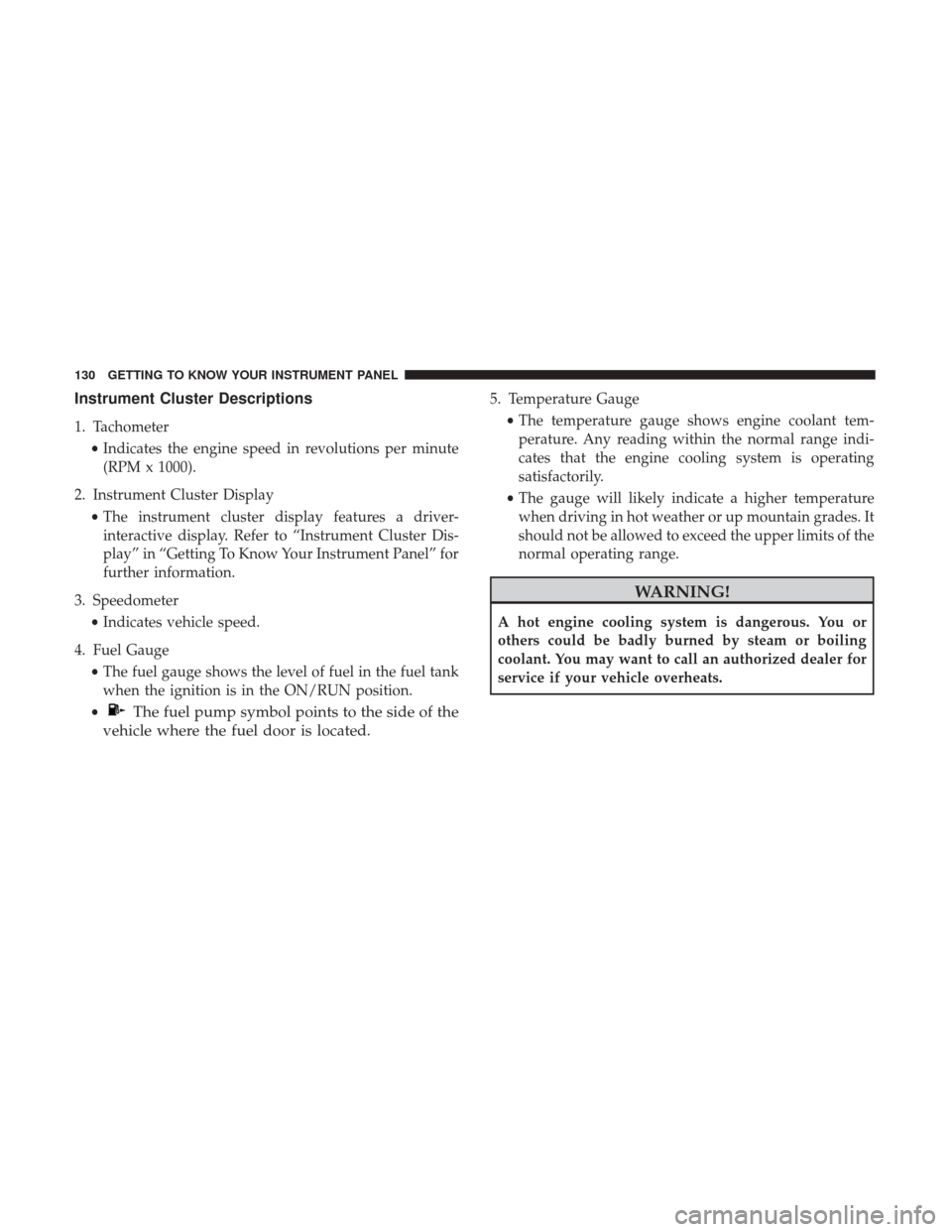
Instrument Cluster Descriptions
1. Tachometer•Indicates the engine speed in revolutions per minute
(RPM x 1000).
2. Instrument Cluster Display •The instrument cluster display features a driver-
interactive display. Refer to “Instrument Cluster Dis-
play” in “Getting To Know Your Instrument Panel” for
further information.
3. Speedometer •Indicates vehicle speed.
4. Fuel Gauge •The fuel gauge shows the level of fuel in the fuel tank
when the ignition is in the ON/RUN position.
•
The fuel pump symbol points to the side of the
vehicle where the fuel door is located.
5. Temperature Gauge
•The temperature gauge shows engine coolant tem-
perature. Any reading within the normal range indi-
cates that the engine cooling system is operating
satisfactorily.
• The gauge will likely indicate a higher temperature
when driving in hot weather or up mountain grades. It
should not be allowed to exceed the upper limits of the
normal operating range.
WARNING!
A hot engine cooling system is dangerous. You or
others could be badly burned by steam or boiling
coolant. You may want to call an authorized dealer for
service if your vehicle overheats.
130 GETTING TO KNOW YOUR INSTRUMENT PANEL
Page 449 of 615
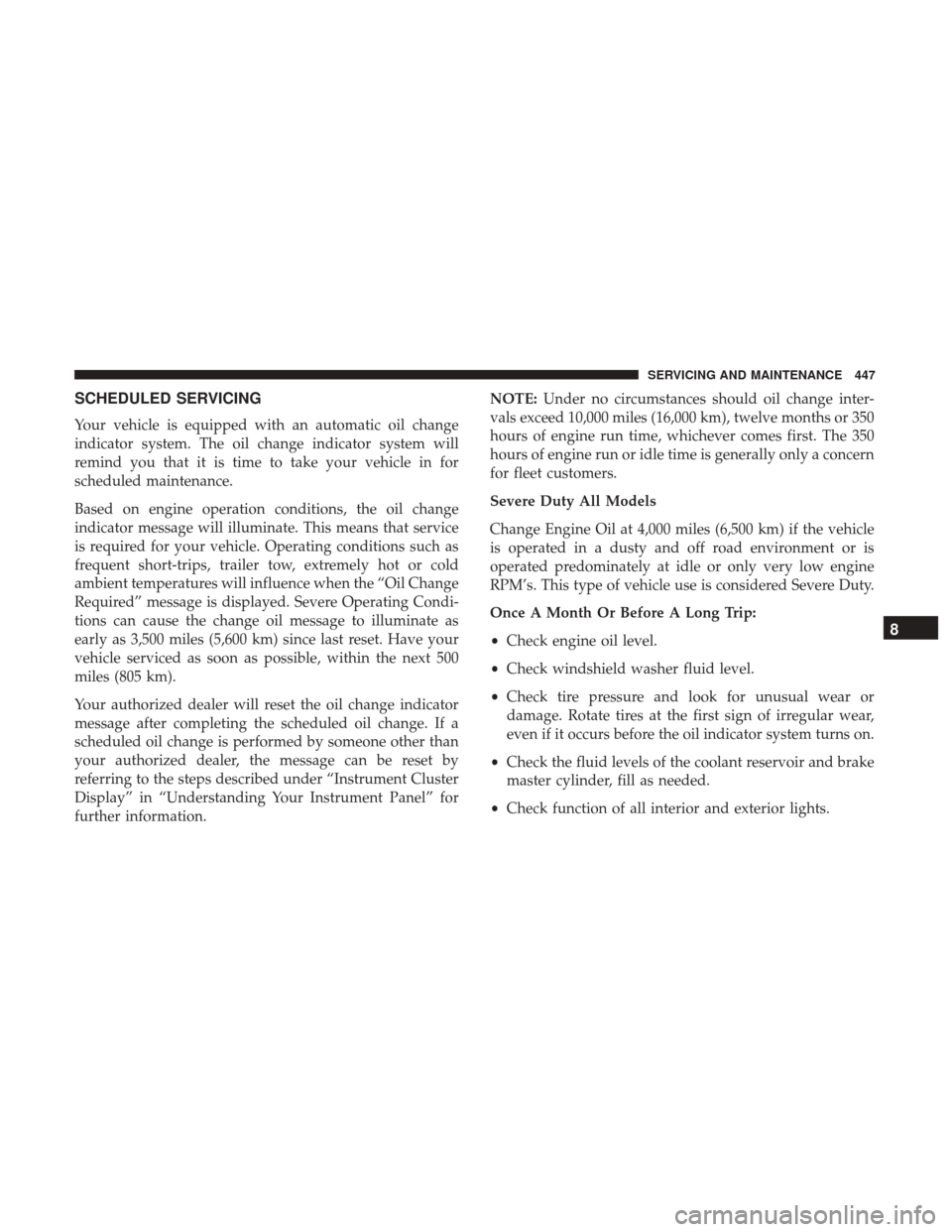
SCHEDULED SERVICING
Your vehicle is equipped with an automatic oil change
indicator system. The oil change indicator system will
remind you that it is time to take your vehicle in for
scheduled maintenance.
Based on engine operation conditions, the oil change
indicator message will illuminate. This means that service
is required for your vehicle. Operating conditions such as
frequent short-trips, trailer tow, extremely hot or cold
ambient temperatures will influence when the “Oil Change
Required” message is displayed. Severe Operating Condi-
tions can cause the change oil message to illuminate as
early as 3,500 miles (5,600 km) since last reset. Have your
vehicle serviced as soon as possible, within the next 500
miles (805 km).
Your authorized dealer will reset the oil change indicator
message after completing the scheduled oil change. If a
scheduled oil change is performed by someone other than
your authorized dealer, the message can be reset by
referring to the steps described under “Instrument Cluster
Display” in “Understanding Your Instrument Panel” for
further information.NOTE:
Under no circumstances should oil change inter-
vals exceed 10,000 miles (16,000 km), twelve months or 350
hours of engine run time, whichever comes first. The 350
hours of engine run or idle time is generally only a concern
for fleet customers.
Severe Duty All Models
Change Engine Oil at 4,000 miles (6,500 km) if the vehicle
is operated in a dusty and off road environment or is
operated predominately at idle or only very low engine
RPM’s. This type of vehicle use is considered Severe Duty.
Once A Month Or Before A Long Trip:
• Check engine oil level.
• Check windshield washer fluid level.
• Check tire pressure and look for unusual wear or
damage. Rotate tires at the first sign of irregular wear,
even if it occurs before the oil indicator system turns on.
• Check the fluid levels of the coolant reservoir and brake
master cylinder, fill as needed.
• Check function of all interior and exterior lights.
8
SERVICING AND MAINTENANCE 447
Page 478 of 615
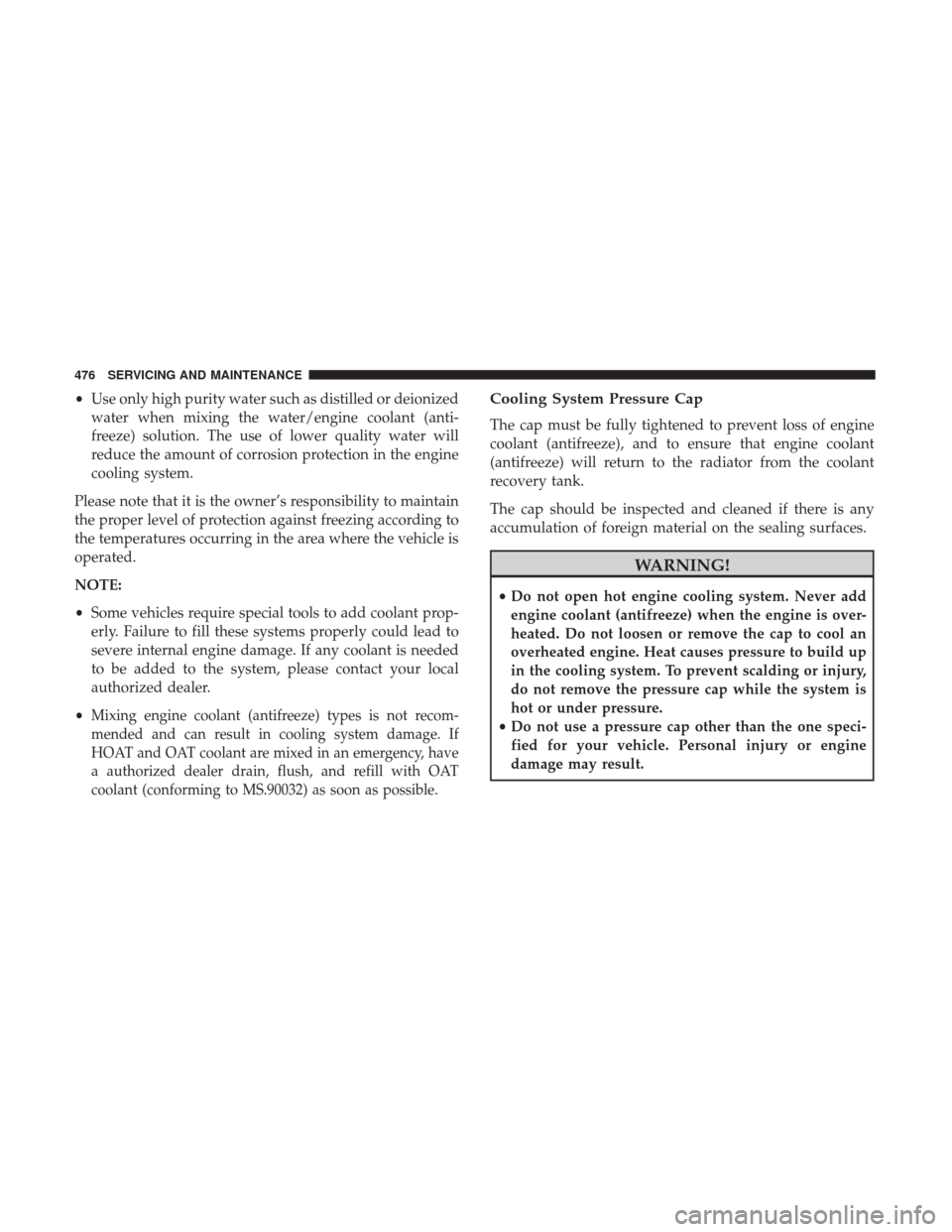
•Use only high purity water such as distilled or deionized
water when mixing the water/engine coolant (anti-
freeze) solution. The use of lower quality water will
reduce the amount of corrosion protection in the engine
cooling system.
Please note that it is the owner’s responsibility to maintain
the proper level of protection against freezing according to
the temperatures occurring in the area where the vehicle is
operated.
NOTE:
• Some vehicles require special tools to add coolant prop-
erly. Failure to fill these systems properly could lead to
severe internal engine damage. If any coolant is needed
to be added to the system, please contact your local
authorized dealer.
•
Mixing engine coolant (antifreeze) types is not recom-
mended and can result in cooling system damage. If
HOAT and OAT coolant are mixed in an emergency, have
a authorized dealer drain, flush, and refill with OAT
coolant (conforming to MS.90032) as soon as possible.
Cooling System Pressure Cap
The cap must be fully tightened to prevent loss of engine
coolant (antifreeze), and to ensure that engine coolant
(antifreeze) will return to the radiator from the coolant
recovery tank.
The cap should be inspected and cleaned if there is any
accumulation of foreign material on the sealing surfaces.
WARNING!
• Do not open hot engine cooling system. Never add
engine coolant (antifreeze) when the engine is over-
heated. Do not loosen or remove the cap to cool an
overheated engine. Heat causes pressure to build up
in the cooling system. To prevent scalding or injury,
do not remove the pressure cap while the system is
hot or under pressure.
• Do not use a pressure cap other than the one speci-
fied for your vehicle. Personal injury or engine
damage may result.
476 SERVICING AND MAINTENANCE
Page 479 of 615
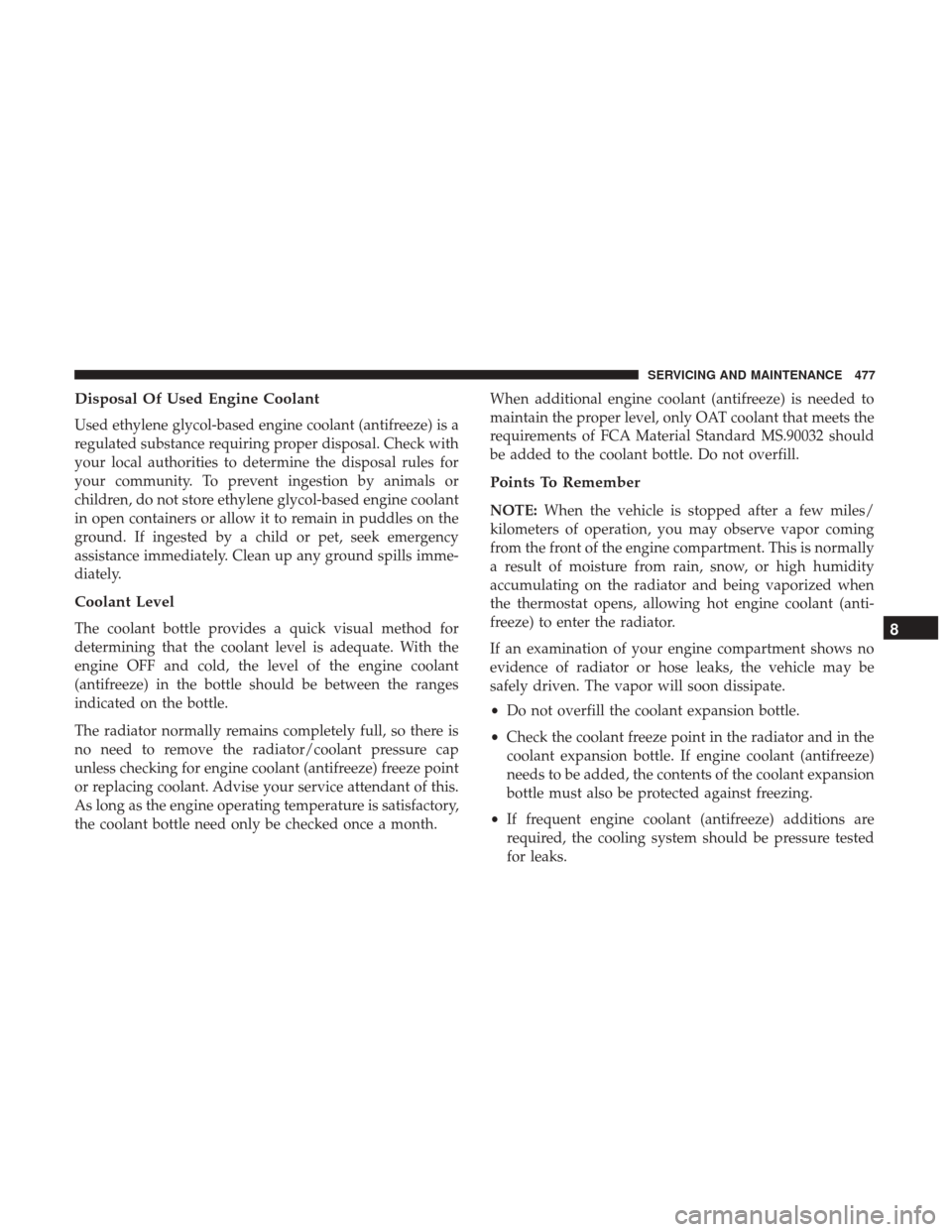
Disposal Of Used Engine Coolant
Used ethylene glycol-based engine coolant (antifreeze) is a
regulated substance requiring proper disposal. Check with
your local authorities to determine the disposal rules for
your community. To prevent ingestion by animals or
children, do not store ethylene glycol-based engine coolant
in open containers or allow it to remain in puddles on the
ground. If ingested by a child or pet, seek emergency
assistance immediately. Clean up any ground spills imme-
diately.
Coolant Level
The coolant bottle provides a quick visual method for
determining that the coolant level is adequate. With the
engine OFF and cold, the level of the engine coolant
(antifreeze) in the bottle should be between the ranges
indicated on the bottle.
The radiator normally remains completely full, so there is
no need to remove the radiator/coolant pressure cap
unless checking for engine coolant (antifreeze) freeze point
or replacing coolant. Advise your service attendant of this.
As long as the engine operating temperature is satisfactory,
the coolant bottle need only be checked once a month.When additional engine coolant (antifreeze) is needed to
maintain the proper level, only OAT coolant that meets the
requirements of FCA Material Standard MS.90032 should
be added to the coolant bottle. Do not overfill.
Points To Remember
NOTE:
When the vehicle is stopped after a few miles/
kilometers of operation, you may observe vapor coming
from the front of the engine compartment. This is normally
a result of moisture from rain, snow, or high humidity
accumulating on the radiator and being vaporized when
the thermostat opens, allowing hot engine coolant (anti-
freeze) to enter the radiator.
If an examination of your engine compartment shows no
evidence of radiator or hose leaks, the vehicle may be
safely driven. The vapor will soon dissipate.
• Do not overfill the coolant expansion bottle.
• Check the coolant freeze point in the radiator and in the
coolant expansion bottle. If engine coolant (antifreeze)
needs to be added, the contents of the coolant expansion
bottle must also be protected against freezing.
• If frequent engine coolant (antifreeze) additions are
required, the cooling system should be pressure tested
for leaks.
8
SERVICING AND MAINTENANCE 477
Page 480 of 615

•Maintain engine coolant (antifreeze) concentration at a
minimum of 50% OAT coolant (conforming to
MS.90032) and distilled water for proper corrosion pro-
tection of your engine which contains aluminum com-
ponents.
• Make sure that the coolant expansion bottle overflow
hoses are not kinked or obstructed.
• Keep the front of the radiator clean. If your vehicle is
equipped with air conditioning, keep the front of the
condenser clean.
• Do not change the thermostat for Summer or Winter
operation. If replacement is ever necessary, install ONLY
the correct type thermostat. Other designs may result in
unsatisfactory engine coolant (antifreeze) performance,
poor gas mileage, and increased emissions.
Brake System
In order to assure brake system performance, all brake
system components should be inspected periodically. Refer
to the “Maintenance Plan” in this section for the proper
maintenance intervals.
WARNING!
Riding the brakes can lead to brake failure and possi-
bly a collision. Driving with your foot resting or riding
on the brake pedal can result in abnormally high brake
temperatures, excessive lining wear, and possible
brake damage. You would not have your full braking
capacity in an emergency.
Fluid Level Check — Brake Master Cylinder
The fluid level of the master cylinder should be checked
whenever the vehicle is serviced, or immediately if the
brake system warning light is on. If necessary, add fluid to
bring level to the full mark on the side of the reservoir of
the brake master cylinder. Be sure to clean the top of the
master cylinder area before removing cap. With disc
brakes, fluid level can be expected to fall as the brake pads
wear. Brake fluid level should be checked when pads are
replaced. If the brake fluid is abnormally low, check system
for leaks.
Refer to “Fluids And Lubricants” in “Technical Specifica-
tions” for further information.
478 SERVICING AND MAINTENANCE
Page 523 of 615
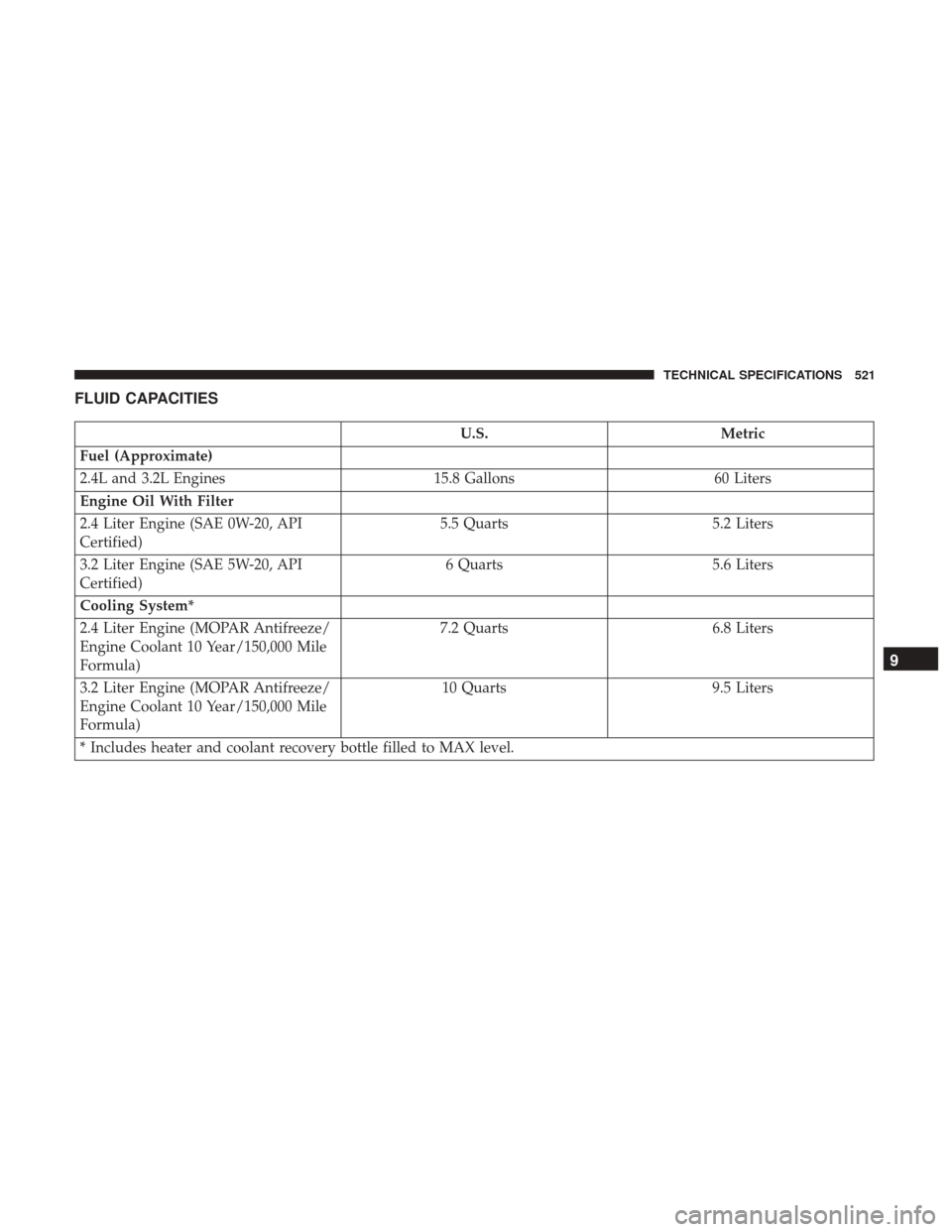
FLUID CAPACITIES
U.S.Metric
Fuel (Approximate)
2.4L and 3.2L Engines 15.8 Gallons60 Liters
Engine Oil With Filter
2.4 Liter Engine (SAE 0W-20, API
Certified) 5.5 Quarts
5.2 Liters
3.2 Liter Engine (SAE 5W-20, API
Certified) 6 Quarts
5.6 Liters
Cooling System*
2.4 Liter Engine (MOPAR Antifreeze/
Engine Coolant 10 Year/150,000 Mile
Formula) 7.2 Quarts
6.8 Liters
3.2 Liter Engine (MOPAR Antifreeze/
Engine Coolant 10 Year/150,000 Mile
Formula) 10 Quarts
9.5 Liters
* Includes heater and coolant recovery bottle filled to MAX level.
9
TECHNICAL SPECIFICATIONS 521
Page 601 of 615
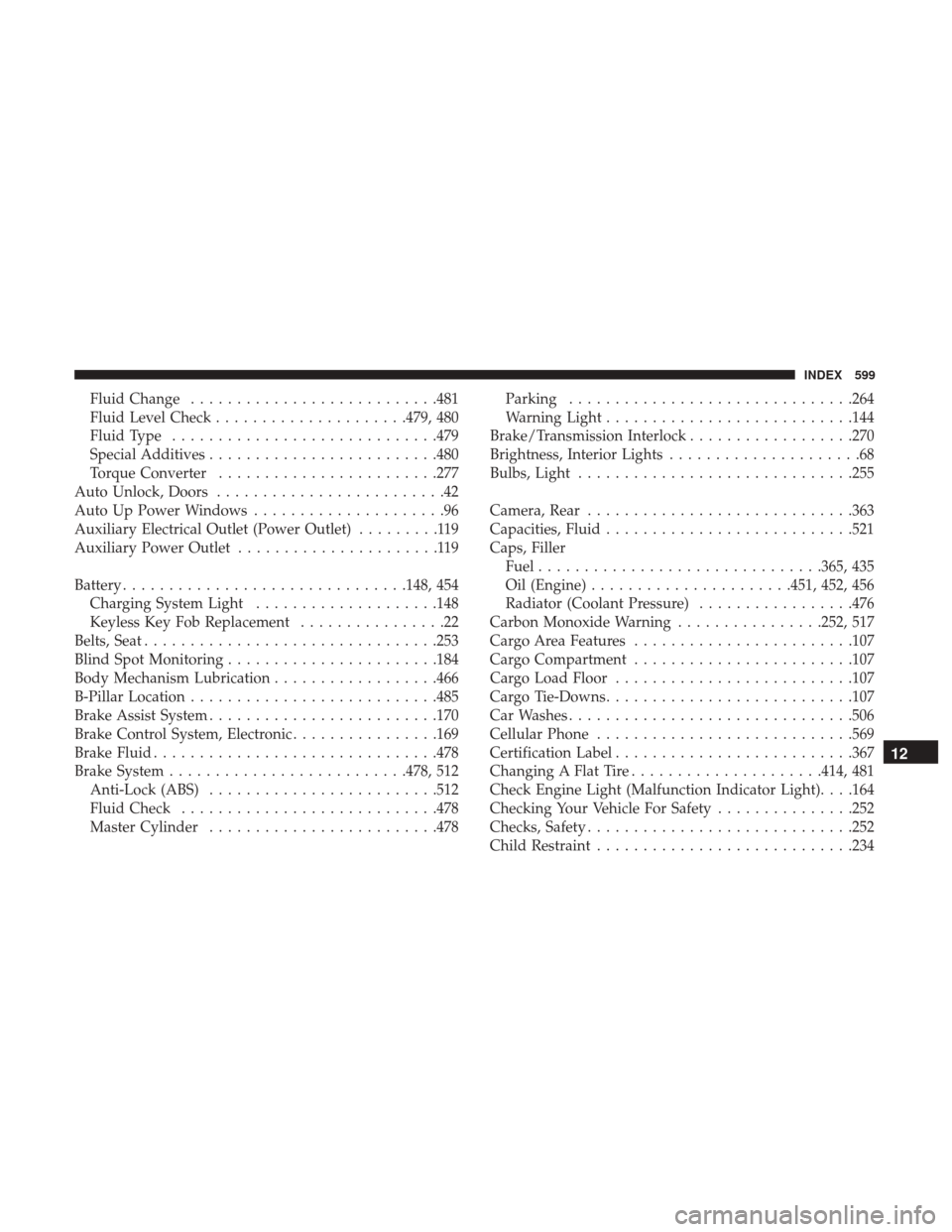
Fluid Change.......................... .481
Fluid Level Check .....................479, 480
Fluid Type ............................ .479
Special Additives ........................ .480
Torque Converter ....................... .277
Auto Unlock, Doors .........................42
Auto Up Power Windows .....................96
Auxiliary Electrical Outlet (Power Outlet) .........119
Auxiliary Power Outlet ......................119
Battery .............................. .148, 454
Charging System Light ....................148
Keyless Key Fob Replacement ................22
Belts, Seat ............................... .253
Blind Spot Monitoring ...................... .184
Body Mechanism Lubrication ..................466
B-Pillar Location .......................... .485
Brake Assist System ........................ .170
Brake Control System, Electronic ................169
Brake Fluid .............................. .478
Brake System ......................... .478, 512
Anti-Lock (ABS) ........................ .512
Fluid Check ........................... .478
Master Cylinder ........................ .478Parking
.............................. .264
Warning Light .......................... .144
Brake/Transmission Interlock ..................270
Brightness, Interior Lights .....................68
Bulbs, Light ............................. .255
Camera, Rear ............................ .363
Capacities, Fluid .......................... .521
Caps, Filler Fuel .............................. .365, 435
Oil (Engine) ..................... .451, 452, 456
Radiator (Coolant Pressure) .................476
Carbon Monoxide Warning ................252, 517
Cargo Area Features ....................... .107
Cargo Compartment ....................... .107
Car
go Load Floor ......................... .107
Cargo Tie-Downs .......................... .107
Car Washes .............................. .506
Cellular Phone ........................... .569
Certification Label ......................... .367
Changing A Flat Tire .....................414, 481
Check Engine Light (Malfunction Indicator Light). . . .164
Checking Your Vehicle For Safety ...............252
Checks, Safety ............................ .252
Child Restraint ........................... .234
12
INDEX 599
Page 602 of 615
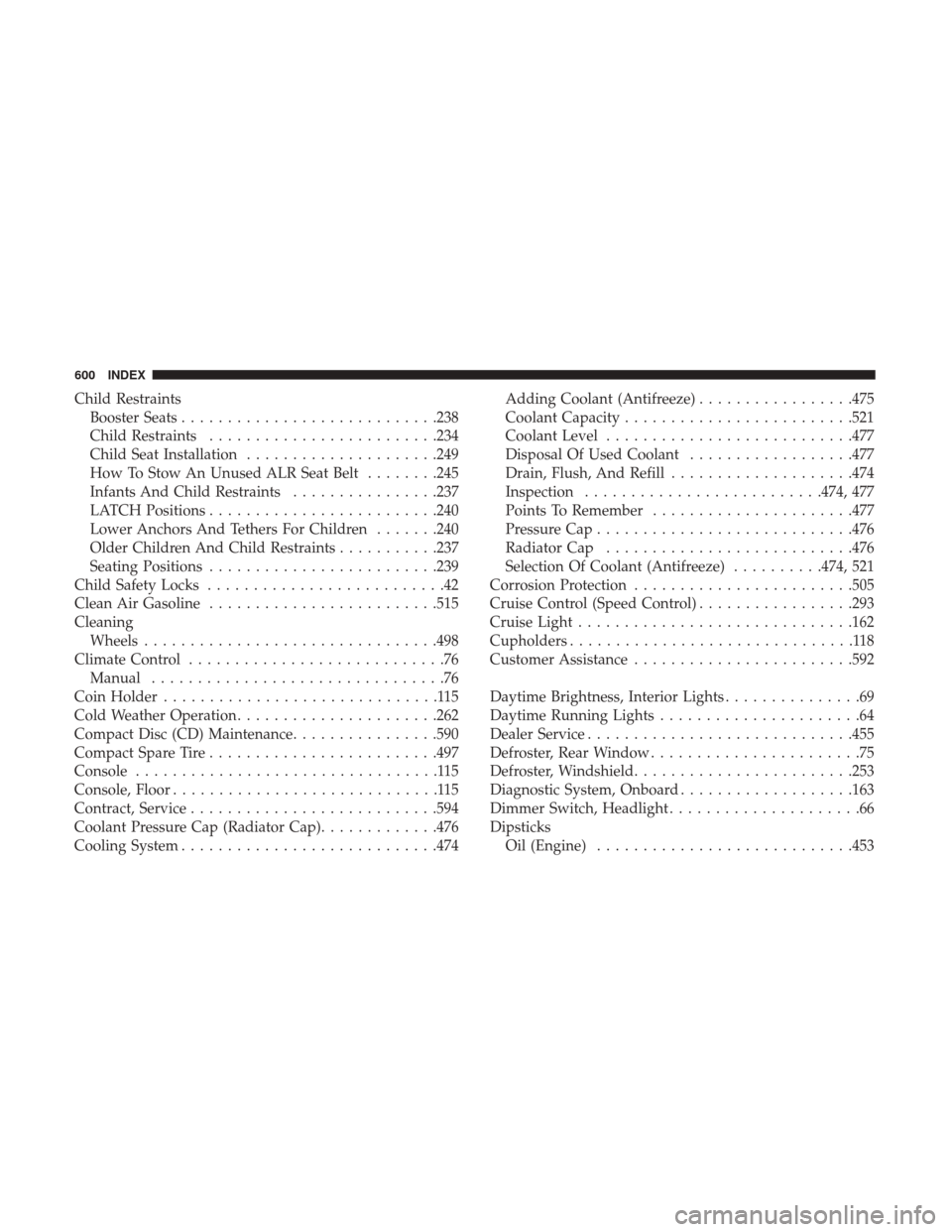
Child RestraintsBooster Seats ........................... .238
Child Restraints ........................ .234
Child Seat Installation .....................249
How To Stow An Unused ALR Seat Belt ........245
Infants And Child Restraints ................237
LATCH Positions ........................ .240
Lower Anchors And Tethers For Children .......240
Older Children And Child Restraints ...........237
Seating Positions ........................ .239
Child Safety Locks ..........................42
Clean Air Gasoline ........................ .515
Cleaning Wheels ............................... .498
Climate Control ............................76
Manual ................................76
Coin Holder ..............................115
Cold Weather Operation ..................... .262
Compact Disc (CD) Maintenance ................590
Compact Spare Tire ........................ .497
Console .................................115
Console, Floor .............................115
Contract, Service .......................... .594
Coolant Pressure Cap (Radiator Cap) .............476
Cooling System ........................... .474Adding Coolant (Antifreeze)
.................475
Coolant Capacity ........................ .521
Coolant Level .......................... .477
Disposal Of Used Coolant ..................477
Drain, Flush, And Refill ....................474
Inspection ......................... .474, 477
Points To Remember ..................... .477
Pressure Cap ........................... .476
Radiator Cap .......................... .476
Selection Of Coolant (Antifreeze) ..........474, 521
Corrosion Protection ....................... .505
Cruise Control (Speed Control) .................293
Cruise Light ............................. .162
Cupholders ...............................
118
Customer Assistance ....................... .592
Daytime Brightness, Interior Lights ...............69
Daytime Running Lights ......................64
Dealer Service ............................ .455
Defroster, Rear Window .......................75
Defroster, Windshield ....................... .253
Diagnostic System, Onboard ...................163
Dimmer Switch, Headlight .....................66
Dipsticks Oil (Engine) ........................... .453
600 INDEX
Page 603 of 615
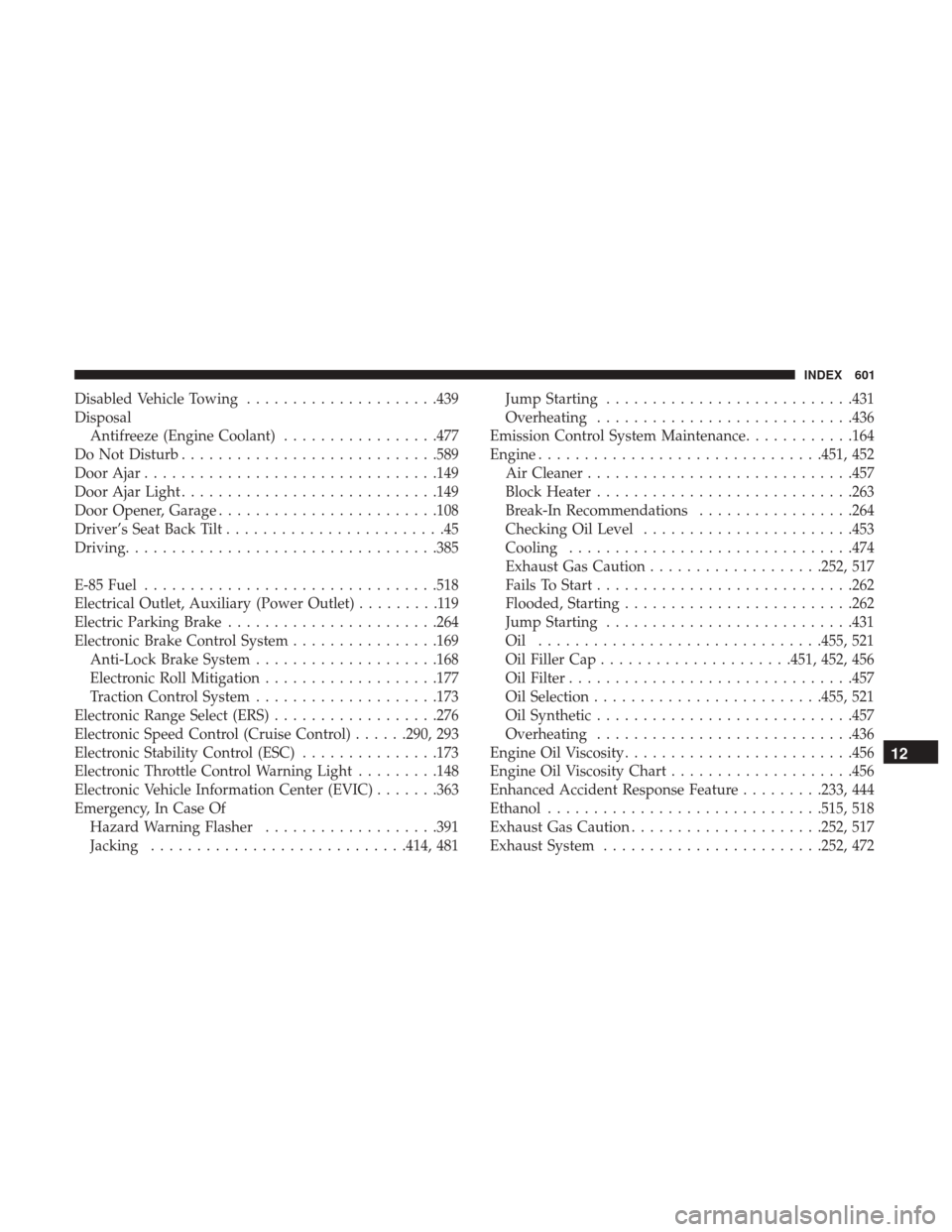
Disabled Vehicle Towing.....................439
Disposal Antifreeze (Engine Coolant) .................477
Do Not Disturb ........................... .589
Door Ajar ............................... .149
Door Ajar Light ........................... .149
Door Opener, Garage ....................... .108
Driver’s Seat Back Tilt ........................45
Driving ................................. .385
E-85 Fuel ............................... .518
Electrical Outlet, Auxiliary (Power Outlet) .........119
Electric Parking Brake ...................... .264
Electronic Brake Control System ................169
Anti-Lock Brake System ....................168
Electronic Roll Mitigation ...................177
Traction Control System ....................173
Electronic Range Select (ERS)..................276
Electronic Speed Control (Cruise Control) ......290, 293
Electronic Stability Control (ESC) ...............173
Electronic Throttle Control Warning Light .........148
Electronic Vehicle Information Center (EVIC) .......363
Emergency, In Case Of Hazard Warning Flasher ...................391
Jacking ........................... .414, 481Jump Starting
.......................... .431
Overheating ........................... .436
Emission Control System Maintenance ............164
Engine .............................. .451, 452
Air Cleaner ............................ .457
Block Heater ........................... .263
Break-In Recommendations .................264
Checking Oil Level ...................... .453
Cooling .............................. .474
Exhaust Gas Caution ...................252, 517
Fails To Start ........................... .262
Flooded, Starting ........................ .262
Jump
Starting .......................... .431
Oil .............................. .455, 521
Oil Filler Cap .....................451, 452, 456
Oil Filter .............................. .457
Oil Selection ........................ .455, 521
Oil Synthetic ........................... .457
Overheating ........................... .436
Engine Oil Viscosity ........................ .456
Engine Oil Viscosity Chart ....................456
Enhanced Accident Response Feature .........233, 444
Ethanol ............................. .515, 518
Exhaust Gas Caution .....................252, 517
Exhaust System ....................... .252, 472
12
INDEX 601